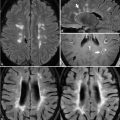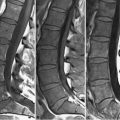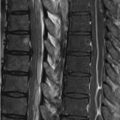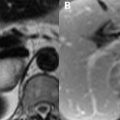94 Other Ankle and Foot Disorders Osteochondral lesions of the talus may arise as a result of direct injury or repetitive microtrauma. Figure 94.1A is an example of such a lesion with a displaced fragment clearly seen within the posterosuperior aspect of the posterior subtalar facet on sagittal FS T2WI. Homogeneous hyperintensity within the calcaneus and talus correlates with associated bone contusion (better appreciated as hypointensity on T1WI). Talar osteochondral lesions are divided into five categories by the MRI criteria devised by Hepple. Stage 1 lesions are radiographically occult, consisting of damage to only the articular cartilage. Concomitant cartilaginous and osseous fractures with and without edema comprise stage 2A and 2B lesions, respectively. A detached but nondisplaced fragment is seen in stage 3. Fragment displacement constitutes a stage 4 lesion. Stage 5 lesions are marked by subchondral cyst formation. Figures 94.1B and 94.1C demonstrate an osteochondral lesion within the posteromedial talus. Inferior and superior portions of the medial cortical surface are disrupted on both coronal (B) T1WI and (C) FS T2WI. Superiorly, formation of a subchondral cyst is best appreciated on (C) FS T2WI, consistent with a grade 5 lesion. Edema—hypo- and hyperintense on the T1WI and FS T2WI, respectively—is seen throughout the talus. In the midst of this edema on the (C
![]()
Stay updated, free articles. Join our Telegram channel

Full access? Get Clinical Tree








